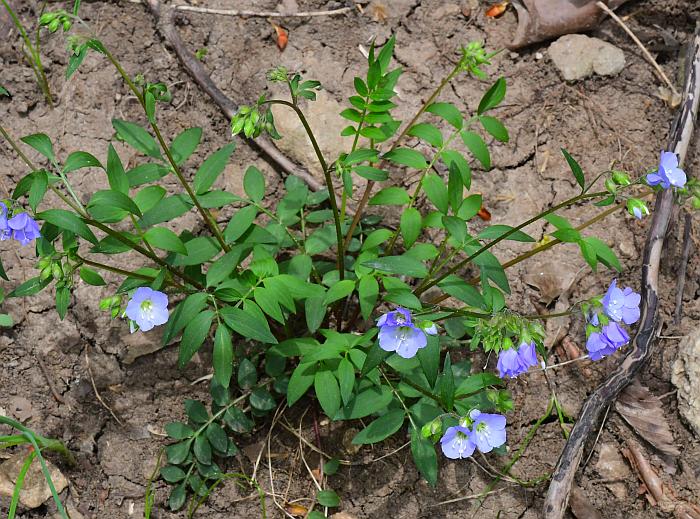Polemonium reptans L.
Jacob's Ladder

Native
CC = 6
CW = 3
MOC = 55
© SRTurner
Polemonium reptans L.Jacob's Ladder | |
 |
Native CC = 6 CW = 3 MOC = 55 |
© SRTurner |
|
Family - Polemoniaceae Habit - Perennial forb from a woody rootstock. Stems - Loosely ascending to weakly erect, to 50 cm, often multiple from the base, often branched, glabrous or sparsely pubescent with fine, spreading, nonglandular, hairs, hollow.
Leaves - Basal and alternate, mostly petiolate, odd-pinnate, to 20 cm. Rachis and petiole winged from decurrent leaf tissue. Blades narrowly oblong in outline or those of the smallest leaves broadly ovate-triangular in outline, pinnately compound with 7-19 leaflets. Leaflets 7-50 mm long, oval to ovate or lanceolate, angled to usually sharply pointed tips, the midvein extended into a short, thickened projection, the margins otherwise entire, the surfaces glabrous or sparsely and minutely hairy along the main veins, the venation pinnate or appearing palmate, with the relatively few secondary veins looping to rejoin the midvein at the tip.
Inflorescence - Terminal and axillary, open panicles with mostly 5-17 flowers, these variously ascending to nodding. Pedicels and peduncles to 5 mm long, densely short glandular-pubescent.
Flowers - Calyces 5-lobed to near the midpoint, 4-6 mm long at flowering, becoming enlarged to 8-12 mm at fruiting, bell-shaped (becoming papery and somewhat inflated at fruiting), the tube uniform in texture, the lobes triangular-ovate, angled to sharply pointed tips, glabrous or sparsely and minutely hairy. Corollas funnelform, 5-lobed, powder blue to lavender, bell-shaped, the tube 5-7 mm long, the lobes 5-8 mm long, glabrous. Stamens with the filaments attached equally in the tube, but unequal in lengths, the anthers thus unequally exserted (2 stamens slightly shorter than the other 3). Anthers white, 2mm long. Style exserted. Ovary green, spherical, 1.3 mm long, 1 mm in diameter, 3-locular, with a large nectary at base. Placentation axile.
Fruits - Capsules. Seeds 15-21, 2-3 mm long, asymmetrically narrowly ellipsoid to oblong-ellipsoid, with a fine longitudinal line or groove along 1 side and narrow wings at one or both ends, the surface dark brown, with short wrinkles, not becoming sticky when moistened.
Flowering - April - June. Habitat - Bottomland forests, mesic upland forests, bases of bluffs, streambanks. Origin - Native to the U.S. Lookalikes - None. Other info. - This delicate springtime wildflower is found across most of Missouri, less commonly in the northwestern third of the state. It occurs in most of the upper Midwest and into New England and Canada. It is an easily recognized species, having pastel blue flowers with white anthers on the stamens (when fresh). The pinnately divided leaves are also very distinctive, with a ladderlike aspect which accounts for the common name. The plant is quite showy in flower and would do well in a rich, moist, shaded garden area. Photographs taken off the MKT Trail, Columbia, MO., 4-15-04 (DETenaglia); also at Cuivre River State Park, Lincoln County, MO, 4-2-2012, Young Conservation Area, Jefferson County, MO, 4-17-2013 and 5-2-2013, Don Robinson State Park, Jefferson County, MO, 4-7-2017, Bootleg Access, Washington County, MO, 4-7-2020, near the Bald Ridge Creek, Pulaski County, MO, 4-19-2021; and at Shaw Nature Reserve, Franklin County, MO, 5-9-2023 and 4-17-2025 (SRTurner). |